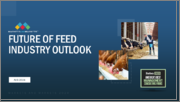
|
시장보고서
상품코드
1546366
세계 사료 산업 시장의 미래 : 예측(-2024년)Future of Feed Industry Market - Global Forecast to 2024 |
||||||
동물 건강과 생산성에 있으며, 영양의 중요성에 대한 이해도가 높아짐에 따라 다양한 동물 종과 개별 동물의 특정 요구에 맞는 사료 솔루션에 대한 수요가 증가하고 있습니다.
생명공학, 데이터 분석, 정밀 사료 공급 기술의 혁신은 보다 효과적이고 개인화된 사료 솔루션을 개발할 수 있게 해줍니다. 예를 들어 더블린에 본사를 둔 애그테크 기업 카인투스(Cainthus)는 AI를 통해 소를 24시간 365일 실시간으로 모니터링하는 ALUS Nutrition 시스템을 개발했습니다. 이 기술에는 소의 행동과 섭식 패턴을 지속적으로 관찰하고 분석하는 스마트 카메라 시스템이 포함되어 있습니다. 이 낙농가는 수돗물에 흐르는 미행 전류가 젖소의 유량과 건강 전반에 악영향을 미치고 있다는 사실을 발견했고, AI를 활용한 모니터링 시스템을 통해 이 문제를 조기에 발견해 문제를 해결하고유량 감소를 방지하고 젖소의 건강을 유지할 수 있었습니다. 이 사례는 AI 기술이 눈에 보이지 않는 문제를 찾아내어 해결함으로써 생산성과 동물 복지를 향상시킬 수 있다는 점을 강조하고 있습니다.
인도의 eFeed는 인공지능을 활용한 첨단 동물 관리 및 영양학 전문 기업입니다. 이 회사는 동물의 생산성을 높이고 메탄 배출량을 줄이기 위해 개인화된 사료를 권장하고 있으며, AI를 활용한 사료 추천을 통해 가축의 생산성을 높이고 메탄 배출량을 줄였습니다. 이는 보다 효율적인 생산과 환경적 지속가능성을 향한 업계의 움직임을 보여줍니다.
사료 산업은 기술 발전과 전략적 파트너십을 통해 혁신적인 변화를 목격하고 있습니다. 카길과 더블린의 머신비전 기업 카인투스(Cainthus)와의 전략적 파트너십은 이러한 변화를 잘 보여주는 사례로, 카길은 카인투스의 얼굴 인식 기술을 전 세계 낙농 농장에 적용함으로써 AI를 활용해 가축의 건강과 복지를 향상시킬 수 있게 되었습니다. 카길은 전 세계 낙농 농장에 도입하여 AI를 활용하여 가축의 건강과 복지를 보다 효과적으로 모니터링하고 있습니다. 이 기술은 사료 및 물 섭취량, 발정 감지, 행동 패턴과 같은 중요한 데이터 포인트를 추적하여 우유 생산, 번식 관리 및 가축의 전반적인 건강을 개선하는 데이터베이스 의사결정을 가능하게 합니다.
세계의 사료 산업 시장에 대해 조사했으며, 가축별 시장 시나리오, 지역별 동향 및 향후 시장 전망 등을 정리하여 전해드립니다.
목차
제1장 개요
제2장 세계 거시경제 분석
제3장 사료 산업에 영향을 미치는 세계의 메가트렌드
- 지속가능성, 환경 문제, 동물 복지
- 항생제의 삭감
- 정밀 영양
- 맞춤형 피드 솔루션
- 대체 단백질원
- 사료첨가제 및 보충제
제4장 지역별 사료 산업의 시장 시나리오
- 세계 분석
- 지역 분석
- 북미
- 유럽
- 아시아태평양
- 기타 지역
제5장 사료 산업의 시장 시나리오, 가축별
- 양식업
- 소
- 돼지
- 가금
제6장 소비자의 동향과 선호도
제7장 사료에서 기술 주도의 진보
- 사료 산업에서 자동화, 로봇 공학, 테크놀러지의 역할
- 친환경 미래의 촉진 : 차세대 사료를 위한 기술
제8장 사료 산업 혁신과 기술 진보 로드맵
제9장 사료 산업의 주요 발전
- 사료 가공 기술의 혁신
- 사료 조사에서의 협력
- 새로운 사료 원료와 배합
- 사료 산업에서의 최첨단 스타트업
제10장 시장 역학
제11장 부록
KSA 24.09.10With a growing understanding of the importance of nutrition in animal health and productivity, there is a rising demand for feed solutions tailored to the specific needs of different species and even individual animals. Innovations in biotechnology, data analytics, and precision feeding technologies are enabling the development of more effective and personalized feed solutions. For instance, Cainthus, an agtech firm based in Dublin, developed the ALUS Nutrition system, which employs AI to monitor cows in real-time, 24/7. This technology involves a smart camera system that continuously observes and analyzes cow behavior and feeding patterns. The farmer discovered a stray electric current running through the water supply, which was negatively impacting the cows' milk production and overall health. By identifying this issue early through the AI-driven monitoring system, the farmer rectified the problem, preventing a decline in milk production and maintaining the health of the cows. This case highlights how AI technology can identify and address issues that may not be immediately apparent, thereby enhancing productivity and animal welfare.
More and more startups are entering the feed industry. eFeed, an Indian company, specializes in advanced animal management and nutrition using artificial intelligence. They create personalized feed recommendations to enhance animal productivity and decrease methane emissions. The implementation of these AI-based feed recommendations has resulted in improved animal productivity and reduced methane emissions. This illustrates the industry's movement towards more efficient production and environmental sustainability.
Strategic Partnership Propel Growth in the Future of Feed Industry
The feed industry is witnessing a transformative shift driven by technological advancements and strategic partnerships. These collaborations are not only fostering innovation but also enhancing productivity, sustainability, and profitability within the sector. Cargill's strategic partnership with Cainthus, a Dublin-based machine vision company, exemplifies this trend. By integrating Cainthus' facial recognition technology into dairy farms worldwide, Cargill is leveraging AI to monitor livestock health and well-being more effectively. This technology tracks critical data points such as food and water intake, heat detection, and behavior patterns, enabling data-driven decisions that improve milk production, reproduction management, and overall animal health.
In addition to this, Cargill's launch of Micronutrition and Health Solutions (MHS) on February 1, 2024, highlights the company's commitment to a holistic approach to animal nutrition. MHS combines a broad portfolio of science-based products, services, and digital solutions to optimize animal performance and health. By considering all microelements-microorganisms, molecules, and micronutrients-impacting animal diets, MHS ensures precise and efficient nutrition management. These advancements underscore the critical role of strategic partnerships and cutting-edge technologies in shaping the future of the feed industry. Through collaborations like that of Cargill and Cainthus, the industry is moving towards more customized and effective feed solutions, ultimately enhancing animal health and farm profitability.
Alternative Protein options are gaining more attraction for animal feed.
The exploration of alternative protein sources such as insects, algae, and single-cell proteins is gaining traction. These alternatives are sustainable and offer high nutritional value, addressing environmental and economic challenges. According to the 2021 WWF Report, "The Future of Feed: A WWF Roadmap to Accelerating Insect Protein in UK Feeds," the demand for insect meal from the UK's pig, poultry, and salmon sectors could reach approximately 540,000 tonnes annually by 2050. Companies are increasingly considering these alternative proteins as sustainable options for animal nutrition, aiming to provide optimal nutrition from the best protein sources. Utilizing these alternatives in feed chains has significant potential to support the transition to a circular economy. Notably, these alternative proteins can convert surplus food, which would otherwise be waste, into high-quality protein, replacing soymeal and fishmeal in animal feed.
Research Coverage:
The Global Feed Industry Outlook for 2024 is poised to provide comprehensive projections on the feed industry's performance, encapsulating major trends such as Nutritional Innovations, Sustainable Feed Ingredients, Enhanced Feed Safety and Quality Standards, Precision Feeding Technologies, Automation and Industry 4.0 in Feed Production, and Ethical Sourcing. This report will scrutinize the feed industry's 2023 performance in comparison to 2022, emphasizing critical developments within the feed landscape during 2023. Additionally, it will explore the key trends in 2024 that are expected to influence the feed industry, including macro-economic shifts, global industry-agnostic trends, and sector-specific advancements. These identified trends will act as the driving forces and constraints shaping the feed industry's trajectory in 2024. By drawing insights from historical performance and forecasting the anticipated impact of these trends, the report will generate predictions for the feed industry in 2024.
Reasons to buy this report:
The report will help the market leaders/new entrants in this market with information on the closest approximations of the revenue numbers for the overall Future of Feed Industry Outlook and the subsegments. This report will help stakeholders understand the competitive landscape and gain more insights to position their businesses better and plan suitable go-to-market strategies. The report also helps stakeholders understand the pulse of the market and provides them with information on key market drivers, restraints, challenges, and opportunities.
The report provides insights on the following pointers:
The report will encompass statistical data and prognostications pertaining to the performance of the feed industry across various metrics, and specific breakdowns for key regions.
This comprehensive analysis will extend to various growing markets, encompassing overall figures, segmentation by types, regional variations, and specific insights into key countries. The major markets discussed in the study are the Plant-Based Protein Market, Precision Fermentation Ingredients Market, Animal Nutrition Market, Feed Additives Market, Feed Automation and Robotics Market, Probiotics Market, Personalized Animal Nutrition Market, Regenerative Agriculture Market, and among others.
TABLE OF CONTENTS
1. EXECUTIVE SUMMARY
- 1.1 TOP DEVELOPMENTS IN 2023
- 1.2 FUTURE PREDICTIONS FOR 2024
2. GLOBAL MACROECONOMIC ANALYSIS
- 2.1 GLOBAL & REGIONAL MACROECONOMIC ANALYSIS
- 2.2 MACROECONOMICS KPIS
3. GLOBAL MEGATRENDS IMPACTING FEED INDUSTRY
- 3.1 SUSTAINABILITY, ENVIRONMENTAL CONCERNS AND ANIMAL WELFARE
- 3.2 ANTIBIOTIC REDUCTION
- 3.3 PRECISION NUTRITION
- 3.4 PERSONALIZED FEED SOLUTIONS
- 3.5 ALTERNATIVE PROTEIN SOURCES
- 3.6 FEED ADDITIVES AND SUPPLEMENTS
4. FEED INDUSTRY MARKET SCENARIO ACROSS REGIONS
- 4.1 GLOBAL ANALYSIS
- 4.1.1 LARGEST MARKETS
- 4.1.2 FASTEST GROWING MARKETS
- 4.2 REGIONAL ANALYSIS
- 4.2.1 NORTH AMERICA
- 4.2.2 EUROPE
- 4.2.3 ASIA PACIFIC
- 4.2.4 REST OF THE WORLD
5. FEED INDUSTRY MARKET SCENARIO BY LIVESTOCK
- 5.1.1 AQUACULTURE
- 5.1.2 CATTLE
- 5.1.3 SWINE
- 5.1.4 POULTRY
6. CONSUMER TRENDS AND PREFERENCES
- 6.1 SHIFTS IN CONSUMER DEMAND
- 6.2 NUTRITIONAL REQUIREMENTS: HOW DO WE FEED OUR LIVESTOCK?
- 6.3 IMPACT OF CONSUMER TRENDS ON FEED FORMULATION
- 6.4 FUTURE PRODUCT MAPPING
7. TECH-DRIVEN ADVANCEMENTS IN FEED
- 7.1 ROLE OF AUTOMATION, ROBOTICS AND TECHNOLOGY IN FEED
- 7.2 ENCOURAGING AN ECOLOGICAL FUTURE: TECHNOLOGIES FOR NEXT-GENERATION FEED
- 7.2.1 DATA-DRIVEN FEED MANAGEMENT
- 7.2.2 PRECISION NUTRITION
- 7.2.3 SMART FARMING SENSORS AND IOT
8. ROADMAP FOR INNOVATION AND TECHNOLOGY ADVANCEMENT IN FEED
9. KEY DEVELOPMENTS IN THE FEED INDUSTRY
- 9.1 INNOVATIONS IN FEED PROCESSING TECHNOLOGIES
- 9.2 COLLABORATION IN FEED RESEARCH
- 9.3 EMERGING FEED INGREDIENTS AND FORMULATIONS
- 9.4 CUTTING-EDGE STARTUPS IN FEED INDUSTRY
- 9.4.1 ANIMAL NUTRITION BASED COMPANIES
- 9.4.2 TECHNOLOGY-BASED COMPANIES
10. MARKET DYNAMICS
- 10.1 DRIVERS OF GROWTH
- 10.2 CHALLENGES AND RESTRAINTS
- 10.3 KEY GROWTH OPPORTUNITIES AND RECOMMENDATIONS
11. APPENDIX
- 11.1 ABOUT MARKETSANDMARKETS
- 11.2 LEGAL DISCLAIMER



















